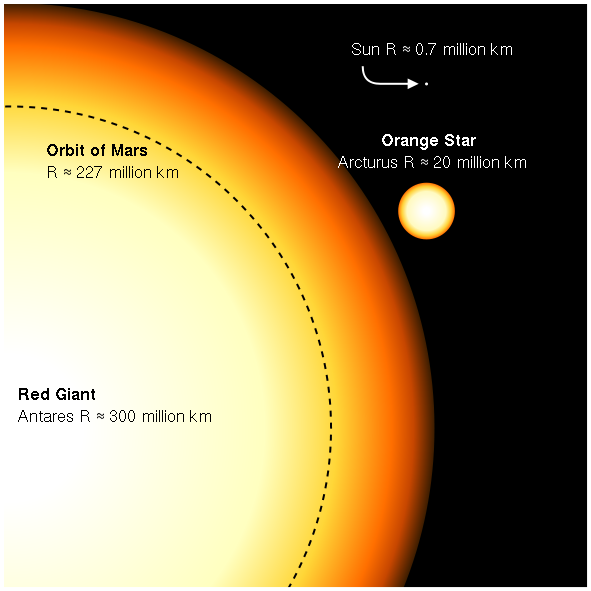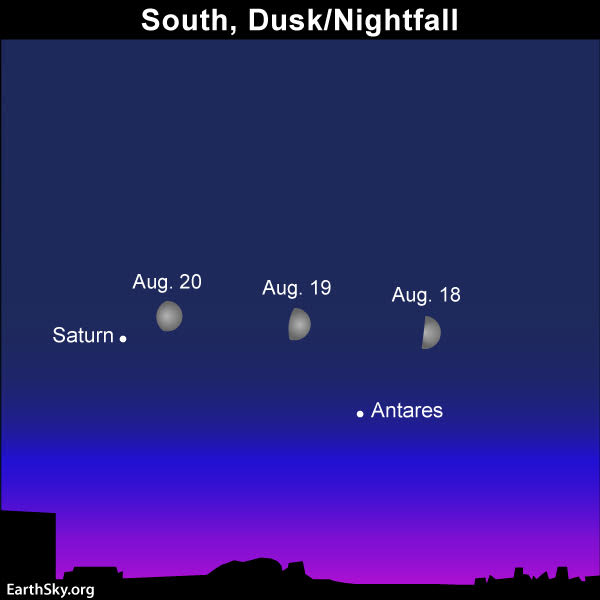On August 18 to 20, 2018, use the moon to find the star Antares and the planet Saturn, the sixth planet outward from the sun. Antares is reddish while Saturn is golden. You might be able to tell that Antares twinkles while Saturn shines with a steadier light.
Keep in mind that the moon on our sky chart appears larger than it does in the real sky.
Antares, the brightest star in the constellation Scorpius the Scorpion, represents the Scorpion’s beating heart. This red gem of a star is truly enormous, with a radius in excess of 3 astronomical units (AU). One AU is the Earth’s average distance from the sun. If by some bit of magic Antares were suddenly substituted for our sun, the surface of the star would extend well past the orbit of Mars!
Antares’ ruddy complexion reveals that this star has a low surface temperature. However, Antares’ great size makes up for its low surface temperature to shine at 1st-magnitude brightness in Earth’s sky. That’s in spite of the fact that Antares lies nearly 600 light-years away.
In the visible spectrum, this red supergiant star has the luminosity of about 10,000 suns. But if we could include invisible infrared radiation, Antares might have as much as 60,000 times the sun’s luminosity.

Now let’s turn our attention to golden Saturn. As you gaze at Saturn, think about the indomitable Cassini spacecraft, which orbited the ringed planet from 2004 to 2017. A year ago, in mid-September 2017, the spacecraft (which had run out of fuel) dive-bombed into the planet’s atmosphere, thereby ending its mission.

Saturn is the most distant world you can easily see with your unaided eye. Plus, you can view Saturn’s majestic rings with nothing more than a modest backyard telescope. All of the four outer planets (planets orbiting the sun outside the asteroid belt) – including Jupiter, Saturn, Uranus and Neptune – have a ring system of sorts.
But Saturn’s rings are the most spectacular by leaps and bounds.
Jupiter, Saturn, Uranus and Neptune are all gas giants (though Uranus and Neptune are sometimes referred to as ice giants). Overall, gas giant and ice giant planets have no solid surfaces. The smaller four inner planets with solid surfaces – Mercury, Venus, Earth and Mars – are called terrestrial or rocky planets.

There are no rings around any terrestrial solar system planet at present. Is there some reason why gas and ice giants have rings whereas terrestrial planets don’t? Cathy Jordon says at Cornell University’s Ask an Astronomer site:
It turns out that all of the planets, Earth included, did have rings at one time. The thing is, these rings were unstable and the material was either lost to space or collected into the satellites of these planets. The difference between the terrestrial and giant planets is the giant planets have the gravity to capture and hold onto a large satellite system, and these satellite systems are the source of the ring material.
It’s thought that Mars’ inner moon Phobos might break up and form a ring around Mars, some 50 million years from now. That’s because this moon is below the synchronous orbit radius – the distance at which the moon orbits Mars in the same time period that Mars rotates upon its axis. Because Phobos’ orbit is unstable, this moon is slowly but surely plunging toward its day of reckoning.
Bottom line: The supergiant star Antares shines red in our sky, and the planet Saturn – glorious ringed world – shines golden. See them near the moon August 18 to 20, 2018.












